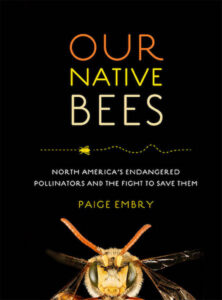Over the past few years, I’ve seen a number of books about bees cross my desk. From reading and reviewing them I’ve learned quite a lot about these amazing creatures; their biology, their ecological significance, and – as particularly emphasized in so many of these books – the challenges they face surviving in the modern world. However it wasn’t until I began reading Paige Embry’s Our Native Bees and learning from it about the astonishing variety of bees there were that an long-standing oversight on my part made itself known to me; what so many of the books about bees I’d previously read were really taking as their subject were not so much “bees” but a particular species of bee: Apis melifera, the European Honey Bee.
Now to give this species its due, A. melifera has played a noteworthy role indeed in agriculture – not only in its native lands but in its naturalized home of North America as well. Many of North America’s largest agricultural crop producers are wholly dependent for their economic success upon the thousands upon thousands of hives filled with these amber-yellow bees trucked from state to state throughout much of the year. And how many of us don’t relish the taste of farm-fresh honey in our teas, on our toast, or gracing a hundred other of our favorite treats? The only problem is that all this attention to one species of non-native bee has left the four thousand native North American species all but entirely neglected – BOB, for example.
BOB, or the Blue Orchard Bee (Osmia lignaria), also called the Blue Orchard Mason Bee, is one of the native North American bees Ms. Embry introduces her readers to in this delightfully eye-opening book. BOB is a low-key sort of bee, solitary by nature (as a significant portion of native bee species are) that is remarkably effective in pollinating fruit trees – if given the chance. In fact, BOB’s work ethic far exceeds that so commonly praised in the European Honey Bee. BOB works in colder temperatures than A. melifera. BOB works in the rain. The only challenge in working with BOB is that things need to be allowed to be a bit more natural – which is the one thing modern, large-scale industrial agriculture can’t easily abide; although some farmers do – and as Ms. Embry explains in her narrative and interviews with them, do so quite well.
But there are far more native bees than just BOB. Through the book, Ms. Embry introduces her readers to the huge, sometimes quite literally “in-your-face” Xylocopa carpenter bees, the diminutive Perdita bees, the ghostly grey kleptoparasitic Neolarra bees, bumble bees, mining bees, sweat bees, tower-building bees, and dozens more. And with these introductions she includes clear and down-to-earth explanations the ecological role these different species play, as well as a collection truly remarkable macro images of that vividly depict just how diverse and beautiful they are.
Ms. Embry’s writing style is superbly suited to her task. Her friendly, humor-filled prose and her over-arching theme of “getting her bee education in public” (she’s a geologist by education and a garden designer by occupation) makes the book particularly inviting to new-comers to the subject. Simultaneously, this same openness to new information and enthusiasm for learning about her subject helps more experienced naturalists to face the reality that they too likely lack significant knowledge about native bees and should thus join with her in learning more about them.
I would find it difficult to believe that anyone, even the most experienced naturalist, could read Our Native Bees and not find in its pages quite a number of things that would be new information to that reader. I would also find it equally difficult to imagine that they wouldn’t also, if asked, say that it was one of the most enjoyable books they’d read in recent memory. For yes, even though not everything is rosy for North America’s native bees, Ms. Embry takes the position that the situation is far from hopeless; for all the while she is introducing her readers to bees they’ve likely not previously met (or at least recognized), she is also introducing them to the people who are making the effort – sometimes small, other times extraordinary – to make the human-altered world more hospitable to the needs of native bees so that the bees can continue to do what they do and as a result make the world a bit more hospitable for humans. It is indeed a classic win-win situation.
 Title: Our Native Bees; North America’s Endangered Pollinators and the Fight to Save Them
Title: Our Native Bees; North America’s Endangered Pollinators and the Fight to Save Them
Author: Paige Embry
Publisher: Timber Press
Format: Hardcover
Pages: 240 pp., 102 color photos, 2 color illustrations
ISBN-13: 9781604697698
Published: February 2018
In accordance with Federal Trade Commission 16 CFR Part 255, it is disclosed that the copy of the book read in order to produce this review was provided gratis to the reviewer by the publisher.
